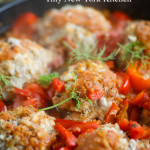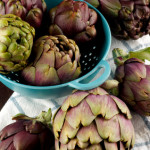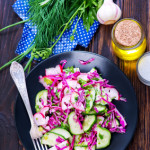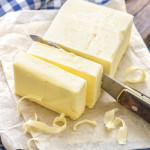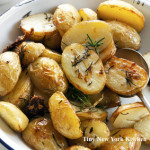Juicy berries are bursting with flavor and now is the perfect time to pick them up, whether for snacking or adding to sweet and savory recipes.
Make sure to look for bright, shiny strawberries, and skip any that are smashed, shriveled, or moldy. Their color should be deep and even, with no white or green patches, and they should smell fragrant.
Wait to wash them. Water increases the risk of mold, so leave berries in their original packaging and rinse in cold running water just before serving. Their shelf life is short, so serve or cook berries within 2 to 3 days.
Despite their sweetness, strawberries are relatively low in sugar. They also provide fiber, antioxidants, and vitamin C. In fact, strawberries contain more vitamin C per serving than oranges!
“Work With What You Got!”
©Tiny New York Kitchen © 2019 All Rights Reserved
The perfect combination of chicken Parm and hearty Italian meatballs. Each bite is packed with cheese and satiating protein. Pair with whole grain pasta or zucchini noodles.
“Work With What You Got!”
©Tiny New York Kitchen © 2019 All Rights Reserved
If vegetables could speak, asparagus would surely say “spring.” While it’s available all year, nothing compares to the fresh spears that appear each spring. Asparagus is one of the first crops of the season, and after a long winter, when green produce is sparse, seeing the tips peek out of the soil is a welcome sight. A short shelf life means it’s best to seek out local asparagus. Look for glossy spears, tightly closed tips, and freshly cut ends.
While green is the most common asparagus, you can often find purple and white spears in stores.
Purple asparagus is grown the same way as green and is also green on the inside. These spears usually taste a bit sweeter and nuttier and are tasty raw.
White asparagus is grown without sunlight, so it doesn’t produce chlorophyll, which keeps it colorless, or white. The stalks should be peeled before cooking. It’s milder in flavor and less grassy than green and best served blanched.
“Work With What You Got!”
©Tiny New York Kitchen © 2019 All Rights Reserved
An ancient symbol of fertility, artichokes are fitting for spring, when we celebrate renewal. Find them year-round – fresh, frozen, canned, and jarred. Artichokes are at their best from March to June.
To Trim Artichokes
Pick off the tough outer leaves until you reach paler, more tender leaves.
With a chef’s knife, cut off the top one-third of the artichoke and all but an inch of the stem.
With a paring knife, cut off the tough green skin on the stem and any tough leaves near the base.
Cut the artichoke in half lengthwise.
With a melon baller or small spoon, scoop out and discard the “choke,” the spiky interior near the stem.
While trimming, keep artichokes in a bowl of water with lots of lemon juice so they don’t turn brown.
“Work With What You Got!”
©Tiny New York Kitchen © 2019 All Rights Reserved
Add this Cucumber Cabbage Salad to your Easter or Passover menu. Fresh dill adds bright spring flavor to this crunchy salad.
It is truly a sign of spring when Fiddleheads appear. Fiddleheads (Ostrich Fern) have a striking appearance, which looks like the neck of a fiddle and tastes somewhere between green beans and asparagus.
Fiddleheads are best served simply. Sauté with a bit of butter and an allium, such as garlic, shallots, or minced onion.
When purchasing fiddleheads, look for fresh bright green, tightly coiled plants. If you see browning that is a sign of age. You’ll want to avoid the browned ones.
To prepare for cooking, wash about 1 1/4 pounds of fiddleheads in cold water and rub away any papery “scales,” then trim the ends. Because the plants are wild, it is wise to make sure they are thoroughly cooked before serving, to avoid the possibility of a food borne illness. The best method is to boil them in salted water for about 10 minutes and then sauté them.
“Work With What You Got!”
©Tiny New York Kitchen © 2019 All Rights Reserved
Eating well just got easier. Use one or more ingredients from each of the five categories. Stick with one international flavor profile. Find a sauce in your market’s global-foods section: ssamjang, chutney, hot sauce, salsa, pesto, chimichurri, romesco, aioli, tahini, or peanut sauce. Save money by using leftovers. Save time by using prechopped fresh vegetables.
CHOOSE A BASE INGREDIENT
1/2 Cup
Cooked Brown Rice, Quinoa, Millet, Bulgur, Farro, Barley, Whole Grain Pasta
CHOOSE A LEAN PROTEIN
3 To 4 Ounces
Cooked Meat, Poultry, Seafood, Legumes, Eggs, Tofu
CHOOSE VEGETABLES
1 To 2 Cups
Vary Colors And Textures
CHOOSE A SAUCE
1 To 3 Tablespoons
Sriracha, Harissa, Soy, Sweet Chili, Ssamjang, Chutney, Hot Sauce, Salsa, Pesto, Chimichurri, Romesco, Aioli, Tahini, Peanut Sauce
Bowl Ideas
Korean: Cooked noodles or rice, shredded carrot, sliced cucumber, sliced daikon radish, bean sprouts, sliced grilled beef, runny fried egg, ssamjang, kimchi
Middle Eastern: Cooked bulgur, roasted eggplant, roasted cauliflower, sautéed spinach, cooked chickpeas, grilled chicken, minted yogurt sauce, roasted pumpkin seeds, za’atar spice blend
Italian: Cooked faro, sautéed zucchini, sautéed kale, roasted red peppers, roasted cherry tomatoes, tuna, pesto, olives, marinated artichoke hearts, pine nuts
“Work With What You Got!”
©Tiny New York Kitchen © 2019 All Rights Reserved
Salted & Unsalted Butter
Butter comes either salted or unsalted (also called sweet). Although all salted butter contains some amount of salt (salt used to be added as a preservative, but today it’s added primarily for flavor), some salted butters are noticeably salty. The problem is the word some. Since the amount of slat can vary from butter to butter, it’s best to use unsalted butter in kitchen and add as much salt as you’d like to each dish. If you prefer salted butter, use it – just remember to adjust the salt in each dish.
Cultured Butter
With this kind of butter, the cream is treated with cultures (like yogurt), allowed to ferment and then churned. The result is a fuller flavor with noticeable acidity. It’s easier to find cultured American butters these days, but as with salted butter, not all cultured butters are the same. A favorite, made by Vermont Creamery, has tang and produces a different sensation on one’s tongue due to its very high butterfat content. Cultured butter is very good to use in baking.
European Butter
The standards for the minimum amount of butterfat in butter are different in Europe and America. Abroad, the minimum is 82 percent; in America it’s 80 percent; everywhere it’s lower for salted butter. When you use European butter you’re likely to have a much richer dish. When I use European butter I don’t make any adjustments to my recipes to make allowances for the difference in butterfat.
Room Temperature Butter
Proper room temperature butter is still slightly cool; it’s really more about texture than temperature. The butter should be soft, but not squishy. The stick should hold it’s shape (a little pressure should leave an indentation), and it should be pliable – if you smash it with a spatula, you shouldn’t have to fight it.
Storing Butter
Keep butter in the refrigerator, well wrapped and away from foods with strong odors. It can be kept in the freezer for almost forever, but let’s call it a year. Defrost overnight in the refrigerator. Butter can keep out at cold room temperature for a day in a butter bell or crock. However, store butter in the refrigerator and then pull it out about 20 minutes before using it.
Clarified Butter
Clarified butter is a magical thing. It’s butter without water (you simmer it away) that won’t burn when used over a high heat. To clarify butter, place the butter in a saucepan, bring it to a simmer, let it bubble gently until it’s covered with foam. Keep simmering the butter until the foam sinks to the bottom and the bubbling just about stops. Line a fine-mesh sieve with cheesecloth or a coffee filter, pour the butter through it into a container, cool and cover. The butter will keep in the fridge for at least 2 months.
“Work With What You Got!”
©Tiny New York Kitchen © 2019 All Rights Reserved
I don’t know what’s more comforting than potatoes. A staple food in many parts of the world, potatoes are an integral part of much of the world’s food supply. Potatoes are the world’s fourth-largest food crop after maize, wheat, and rice.
There are currently over 1,000 different types of potatoes.
White Potatoes: These all-purpose potatoes are moderately starchy with a dense, creamy texture and can be roasted, baked, boiled, or steamed.
Russet Potatoes: Starchy and fluffy, these potatoes are ideal for mashing and baking, as well as French fries and latkes.
Fingerling Potatoes: Small, knobby fingerlings have thin, delicate skin that doesn’t need to be peeled. Their firm texture stands up to roasting, boiling, and pan-frying.
Baby Potatoes: Also known as new potatoes, these tiny potatoes come in a rainbow of colors (another reason to leave the skin on). They are best cooked whole and boiled, steamed, or roasted.
Gold Potatoes: These thin-skinned potatoes (also called yellow potatoes) are beloved for their buttery flesh. They’re fluffy enough to be smashed yet firm enough to be used in soup or stew.
Red Potatoes: Ruby skin gives these potatoes visual appeal, and their firm and waxy texture means they soak up flavor without turning too soft. They are ideal for salads and gratins.
Look for potatoes without any bruises, cuts, wrinkles, or soft spots, which can all be signs of age or poor handling. If they smell like soil, that’s typically an indication of freshness. While fresh is best, potatoes keep for quite some time. Store them in a spot that’s cool, dark, and dry. If eyes sprout, simply cut them off and use the potatoes as normal. Potatoes provide vitamins C and B6, plus iron and potassium. While the whole potato contains fiber, you will get an extra boost if you leave the skin on.
“Work With What You Got!”
©Tiny New York Kitchen © 2019 All Rights Reserved
Cocoa powder is mostly used for pudding and cakes. 100% cocao powder also adds rich earthiness to rubs for roasted or grilled meat.
“Work With What You Got!”
©Tiny New York Kitchen © 2019 All Rights Reserve


